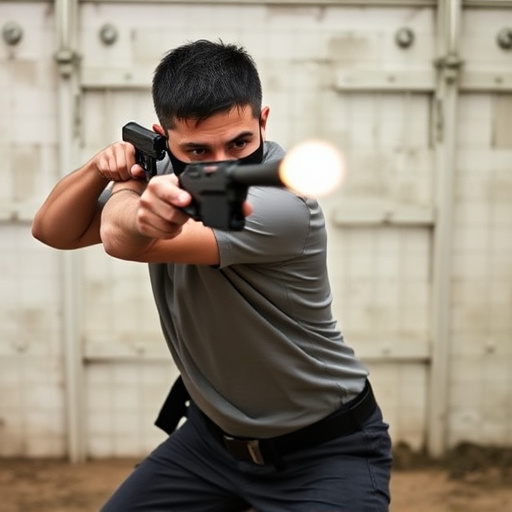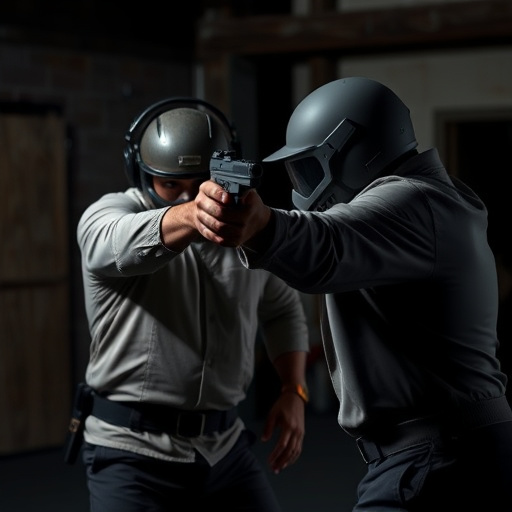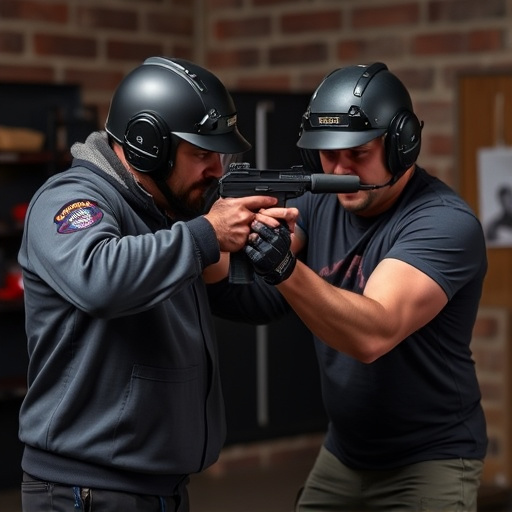Taser deployment temporarily paralyzes individuals for 2-3 seconds, with variations based on device model, distance, body composition, fitness level, medical conditions, and temperature. Proper training is crucial for law enforcement to minimize paralysis duration. Personal users face legal obligations and must buy stun guns that are easy to carry and use, prioritizing compact size, simple activation mechanisms, robust performance, ergonomic design, powerful jolts, safety switches, and intensity control settings while adhering to local regulations. Regular testing, storage in a durable case, keeping it charged, and keeping the device out of children's reach are essential safety measures.
In today’s world, understanding the duration of paralysis after Taser deployment is crucial for both law enforcement and civilians alike. This comprehensive guide delves into the factors influencing the time a person remains paralyzed after Taser use, with a focus on buying and owning stun guns responsibly. We explore legal considerations, regulations, and safety tips, emphasizing the importance of choosing easy-to-carry and effective stun guns for personal protection.
- Understanding Taser Deployment and Paralysis Duration
- Factors Affecting Paralysis Time After Taser Use
- Legal Considerations and Stun Gun Regulations
- Choosing the Right Stun Gun for Easy Carry and Effectiveness
- Training and Safety Tips for Responsible Stun Gun Ownership
Understanding Taser Deployment and Paralysis Duration

Taser deployment involves the use of electroshock weapons to temporarily incapacitate a person. These devices deliver a strong electric current through two probes connected to thin wires, causing muscular paralysis and disorientation for several seconds. The duration of this paralysis is crucial in understanding the effectiveness and potential risks associated with Taser use. Studies show that the average immobilization time for individuals targeted by a Taser is around 2-3 seconds, though it can vary based on factors like the model of Taser, the distance between the device and the target, and individual variations in body composition.
Understanding the typical paralysis duration is essential when considering the safety implications for both law enforcement officers and civilians. It’s why buying stun guns that are easy to carry and use is encouraged—they can serve as alternative non-lethal force options in self-defense scenarios. Moreover, recognizing the limited duration of Taser paralysis highlights the need for proper training and de-escalation strategies among law enforcement personnel to ensure safe and effective deployment.
Factors Affecting Paralysis Time After Taser Use

The duration of paralysis after a Taser deployment varies greatly, influenced by several factors. One key factor is the model and power output of the Taser used; newer models with higher voltage can cause longer periods of immobilization. Additionally, the distance between the operator and the target plays a role—closer ranges typically result in shorter paralysis times due to reduced energy dispersion.
Another significant consideration is the physical condition and muscle tone of the individual being stunned. Individuals with higher levels of fitness or those experiencing certain medical conditions might experience shorter durations of paralysis compared to others. Moreover, environmental factors like temperature can impact how long someone remains paralyzed; heat can speed up recovery, while cold may prolong immobilization. Lastly, proper training for Taser use is essential; officers equipped with adequate skills and knowledge can manage the device more effectively, potentially minimizing paralysis duration by ensuring accurate deployment techniques.
Legal Considerations and Stun Gun Regulations

In the context of using stun guns, or Tasers, there are significant legal considerations and regulations in place to ensure safe and responsible deployment. The duration of paralysis induced by a Taser is a critical factor, with laws dictating both the permissible use and post-deployment protocols. Many jurisdictions require officers to de-escalate situations first, using non-lethal force options before resorting to stun guns, and to cease their use once the target is incapacitated.
When purchasing stun guns for personal protection, it’s essential to consider models that are easy to carry and use, aligning with the principles of self-defense and proportionality. Regulations vary by region, so being informed about local laws is crucial. Easy-to-use stun guns designed with compact sizes and simple activation mechanisms not only facilitate quick deployment in emergencies but also help users avoid excessive force, ensuring compliance with legal guidelines on stun gun regulations.
Choosing the Right Stun Gun for Easy Carry and Effectiveness

When considering a stun gun for personal safety, one key factor is its ease of carry and effectiveness. Opting for stun guns that are compact, lightweight, and designed with ergonomic features ensures they can be easily accessed and used in emergency situations. Look for models that fit comfortably in your hand or pocket, making them convenient to carry everywhere.
Additionally, focus on weapons with powerful jolts and reliable activation mechanisms. Buy stun guns that deliver a strong electric shock capable of immobilizing an assailant while also prioritizing user safety with features like safety switches and control over the intensity settings. This balance between compact design and robust performance guarantees you have a reliable tool for self-defense when needed, making it easy to buy stun guns that are both easy to carry and highly effective.
Training and Safety Tips for Responsible Stun Gun Ownership

When considering buying a stun gun, opt for models that are designed with ease of carrying and use in mind. These devices should be compact, lightweight, and feature simple activation mechanisms. Proper training is paramount; familiarize yourself with local laws regarding stun gun ownership and usage, and attend workshops or courses to learn the best practices for deployment and safety.
Ensure you understand the duration of paralysis induced by a stun gun, as this varies based on factors like model, voltage output, and body parts targeted. Regularly test your device’s functionality and keep it in a readily accessible location. Additionally, invest in a durable carrying case to safeguard the stun gun and ensure its availability when needed. Prioritize safety by storing the device out of reach of children and keeping it charged for immediate use.
In conclusion, understanding the duration of paralysis after Taser deployment is crucial for both law enforcement and civilians alike. By recognizing the factors influencing paralysis time, such as distance, body mass index, and individual variability, users can ensure safer and more effective applications. Choosing the right stun gun that’s easy to carry and use, along with comprehensive training, is essential for responsible ownership. Staying informed about legal considerations and regulations further reinforces safe practice, making these devices valuable tools when faced with potentially dangerous situations.
